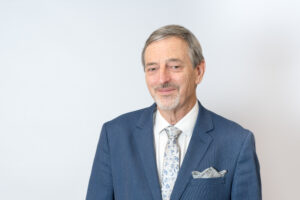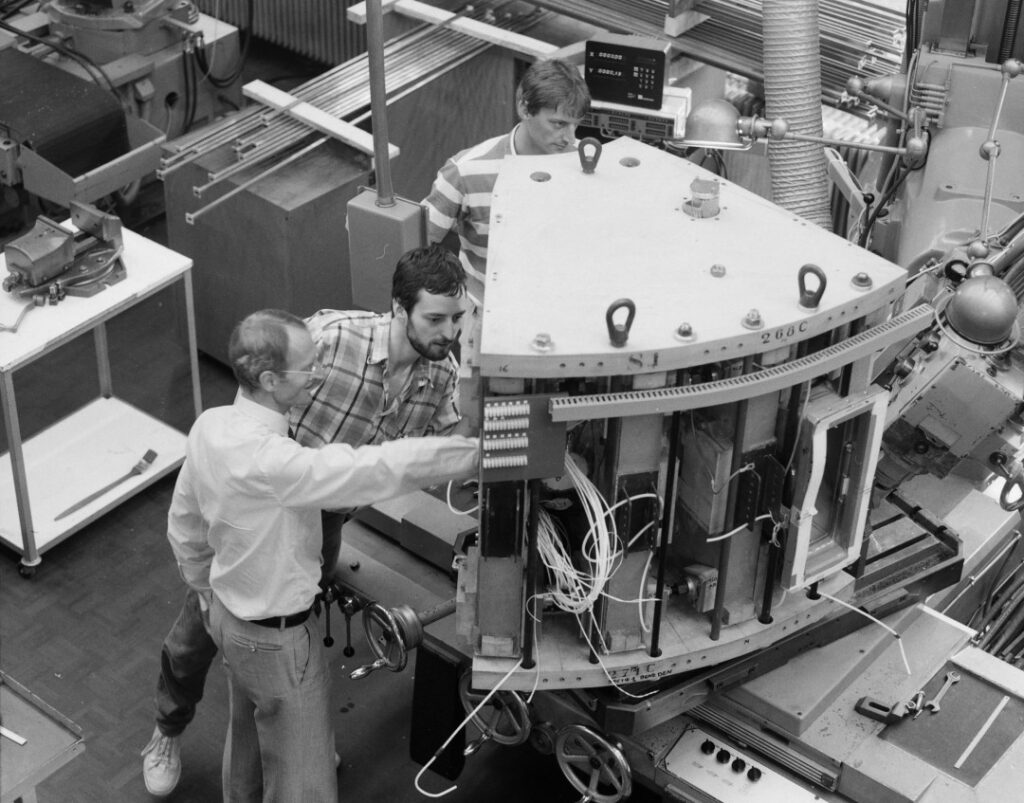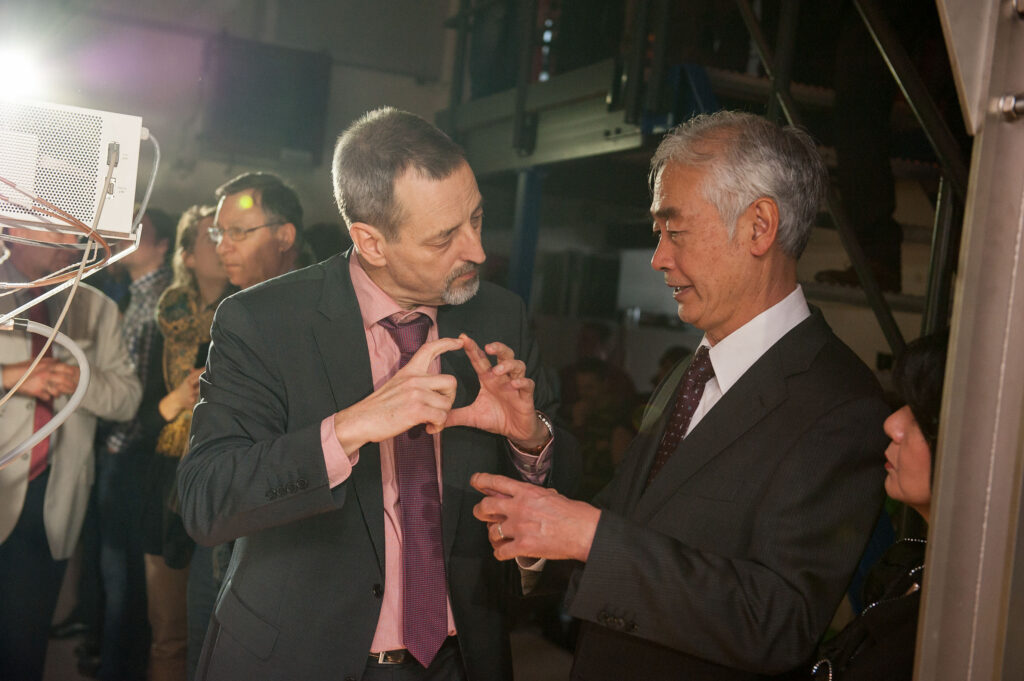
In 1980, you completed your degree in physics cum laude at the University of Utrecht and then obtained your PhD as a particle physicist at the Vrije Universiteit in Amsterdam. How did you end up in the world of fusion?
It was a bit of coincidence. As a student, I had a broad interest, but I honestly found the lecture on plasma physics to be utterly boring! Particle and solid-state physics gripped me much more, and I went to work at Nikhef, the National Institute for Subatomic Physics. After my PhD, several options were on the table to work in America in 1985, but my heart turned out to be in the Netherlands.
A job became available at the Dutch centre for fusion research FOM Rijnhuizen in Nieuwegein. I had never been to the institute before and first wanted to know what the work entailed, what the people were like. I drove there on my wife’s moped, for lack of a good bus connection. I can still see myself arriving there covered in mud. Working on a new measuring instrument insensitive to neutrons seemed interesting and there was a definite click.
From 1985 to 2014 you worked at FOM Rijnhuizen, renamed DIFFER in 2010. How do you look back on that time?
I was productive quickly, in the first year I already had four publications to my name. A year later I got a permanent job as head of the TORTUR tokamak group and a year after that as head of the diagnostics group (measuring instruments) for our new tokamak. That was the Rijnhuizen Tokamak Project (RTP), formerly the French tokamak Petula.
RTP ran for ten years and was scientifically one of my best times. We had a club of some 25 people in total—PhD students, permanent researchers and engineers—and many good ideas for advanced diagnostics that allowed us to look into what the plasma was doing in great detail. Many of our techniques were later adopted by other machines. You could say we were very progressive.
The atmosphere was also good. Once a month, we had a High Intensity Week. We worked double shifts, ate dinner together, worked through the night. And all in a great close-knit team. I think back to it with great pleasure.

By 2014, you had already been head of the fusion department within the institute for five years. What made you choose for a European position then?
I had a good time at the institute, which had just transformed itself into DIFFER. We had a good group of people who knew what we were going for. But something exciting was also happening in Europe. There, we were on the eve of a new way of working together, more strongly focused on a common research programme. All the national laboratories, like DIFFER, still had to get behind that. The question went around: ‘Would you consider…?’ I sent in my application two days before the deadline.
What was your leadership style on that international stage?
I have always worked very internationally with peers from Japan, India, America, Russia and other countries worldwide. And people know me as someone who makes connections. I like to listen to people and bring them together. That was undoubtedly another reason for asking me for this role.
I like to think back to the very first meeting of the General Assembly (GA) of EUROfusion. We had organised it in the Netherlands, at the Avifauna bird park. I lead the meeting, we had to elect a new chair for the GA, and it wasn’t going well. ‘It’s like that group of flamingos over there’, I said to my neighbour: ‘All looking in a different direction’. Then suddenly all the birds looked to the same side—someone was bringing in their food. We decided on the spot to take a food break as well and discuss with colleagues personally to get their beaks facing the same direction. That turned out to be a good basis for our proposal the next day.
Why is EUROfusion so important in your eyes?
EUROfusion coordinates all fusion research in Europe, and all the work that we co-finance thanks to European Commission funds must contribute to the central ‘Roadmap’ towards a fusion power plant. This avoids duplication of efforts, and it ensures that we can share researchers and facilities. Together, we figure out what research is needed, think about the best machine for it and send the most suitable people there. It works extremely well. Even countries without large-scale research machines can thus supply experts and contribute to the larger programme.

What challenges does fusion research currently face?
If we have the resources for it, I am convinced that as Europe we can realise fusion energy within the next 20 years. But then we will have to cooperate in a different way with each other and with industry. They are now mainly seen as contractors: researchers devise equipment and companies build it. Instead, you want industry to co-design.
Companies understand much better than scientists how to design a complex device like a fusion power plant so that the components can be manufactured efficiently and work together. That does require full reimbursement of industry costs, otherwise you won’t get them on board.
Call it a Moonshot-like approach, highly coordinated so that we combine all efforts. Look at the fusion startups; there are now about 50 companies that each want to build their own design fusion reactor. These companies can move much faster and they can afford to make less conservative choices than public research. But they are not yet connected to the bigger picture.
The whole world on one fusion project?
Not necessarily, because healthy competition can also move things forward. Europe, America, China, Korea; many of the ITER members are now each designing their own demonstration fusion power plant. It has become a global competition, but international cooperation remains important for mutual benefit. At the same time, we want Europe to maintain its leading position in fusion research; we have the most thorough, realistic and comprehensive research programme. A ‘go’ from politics including sufficient funds, a quick choice of site and tight evaluation on progress. Bring it on!
Back to your own career. It has many highlights, but what really stands out?
That has to be the RTP period that I mentioned. Much more came out of that project than we had originally dared to hope for. We called it without exaggeration the best diagnosed tokamak in the world: nobody had so much measuring capability per cubic metre of plasma. I also found the EUROfusion time very exciting. It meant more distance from the day-to-day business of science, talking to politicians a lot and totally different challenges than I was used to.
What would you say to students considering a career in fusion?
Maybe this is old-fashioned, but don’t just consult colleagues via email, whatsapp and video call. Sit at a table, have lunch together, talk to each other. You’ll find yourself coming up with new ideas and unexpected connections. That is so enriching!
I love seeing young people enter the field, we need a new generation. There are huge challenges and great opportunities for fusion. What we need to pass on is, first of all, our knowledge, and I’m happy to commit to that in the coming years. But also the drive to realise fusion. Think of the Sagrada Familia cathedral in Barcelona. It took more than a century to build, but it is also nearing completion. There comes a time when it is finished, when fusion becomes a reality.
This article was written by Gieljan de Vries (EUROfusion) and Rianne van Hoek (DIFFER)
